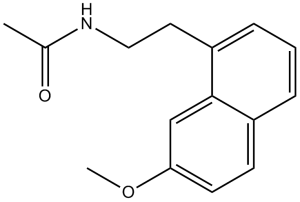Agomelatine (S-20098; BAN, rINN; Valdoxan, Melitor, Thymanax)
This product is for research use only, not for human use. We do not sell to patients.

For small sizes, please check our retail website as below: www.invivochem.com
| Size | Price | Stock |
|---|---|---|
| 2g | $650 | In Stock |
| 5g | $950 | In Stock |
| 10g | $1425 | In Stock |
Cat #: V0974 CAS #: 138112-76-2 Purity ≥ 98%
Description: Agomelatine (S20098; AGO-178; S-20098; AGO178; Valdoxan, Melitor, Thymanax) is a potent and specific agonist of MT1 and MT2 receptors with anti-depressive activity.
Top Publications Citing Invivochem Products
Publications Citing InvivoChem Products
Product Promise

- Physicochemical and Storage Information
- Protocol
- Related Biological Data
- Stock Solution Preparation
- Quality Control Documentation
| Molecular Weight (MW) | 243.3 |
|---|---|
| Molecular Formula | C15H17NO2 |
| CAS No. | 138112-76-2 |
| Storage | -20℃ for 3 years in powder formr |
| -80℃ for 2 years in solvent | |
| Solubility In Vitro | DMSO: 49 mg/mL (201.4 mM)r |
| Water: <1 mg/mLr | |
| Ethanol: 49 mg/mL (201.4 mM) | |
| SMILES Code | CC(=O)NCCC1=CC=CC2=C1C=C(C=C2)OC |
| Synonyms | S20098; Valdoxan; Thymanax; Melitor; AGO 178; N-(2-(7-methoxy-1-naphthyl)ethyl)acetamide; S 20098; AGO-178; AGO178; S-20098 Chemical Name: N-[2-(7-methoxynaphthalen-1-yl)ethyl]acetamide |
| Protocol | In Vivo | Agomelatine (25, 50, or 75 mg/kg; i.p.) has antioxidant activity in Strychnine (75 mg/kg, i.p.) or Pilocarpine (400 mg/kg, i.p.) induced seizure models in mice. Agomelatine dose not have any antioxidant effects on parameters of oxidative stress produced by Pentylenetetrazole (PTZ) or Picrotoxin (PTX) induced seizure models when compared to controls |
|---|---|---|
| Animal model | Female Swiss mice (20-30 g) were administered PTZ (85 mg/kg, i.p.), PTX (7 mg/kg, i.p.), strychnine (75 mg/kg, i.p.), Pilocarpine (400 mg/kg, i.p.), respectively | |
| Dosages | 25, 50, or 75 mg/kg | |
| Administration | Administered intraperitoneally (i.p.) |
These protocols are for reference only. InvivoChem does not
independently validate these methods.
| Solvent volume to be added | Mass (the weight of a compound) | |||
|---|---|---|---|---|
| Mother liquor concentration | 1mg | 5mg | 10mg | 20mg |
| 1mM | 4.1102 mL | 20.5508 mL | 41.1015 mL | 82.2030 mL |
| 5mM | 0.8220 mL | 4.1102 mL | 8.2203 mL | 16.4406 mL |
| 10mM | 0.4110 mL | 2.0551 mL | 4.1102 mL | 8.2203 mL |
| 20mM | 0.2055 mL | 1.0275 mL | 2.0551 mL | 4.1102 mL |
The molarity calculator equation
Mass(g) = Concentration(mol/L) × Volume(L) × Molecular Weight(g/mol)
Mass
=
Concentration
×
Volume
×
Molecular Weight*
The dilution calculator equation
Concentration(start)
×
Volume(start)
=
Concentration(final)
×
Volume(final)
This equation is commonly abbreviated as: C1 V1 = C2 V2
Concentration(start)
C1
×
Volume(start)
V1
=
Concentration(final)
C2
×
Volume(final)
V2
Step One: Enter information below
Dosage mg/kg
Average weight of animals g
Dosing volume per animal µL
Number of animals
Step Two: Enter the in vivo formulation
%DMSO
+
%
+
%Tween 80
+
%ddH2O
Calculation Results:
Working concentration:
mg/ml;
Method for preparing DMSO master liquid:
mg
drug pre-dissolved in
µL
DMSO(Master liquid concentration
mg/mL)
,Please contact us first if the concentration exceeds the DMSO solubility of the batch of drug.
Method for preparing in vivo formulation:
Take
µL
DMSO master liquid, next add
µL
PEG300, mix and clarify, next add
µL
Tween 80,mix and clarify, next add
µL
ddH2O,mix and clarify.
Note:
- (1) Please be sure that the solution is clear before the addition of next solvent. Dissolution methods like vortex, ultrasound or warming and heat may be used to aid dissolving.
- (2) Be sure to add the solvent(s) in order.




































